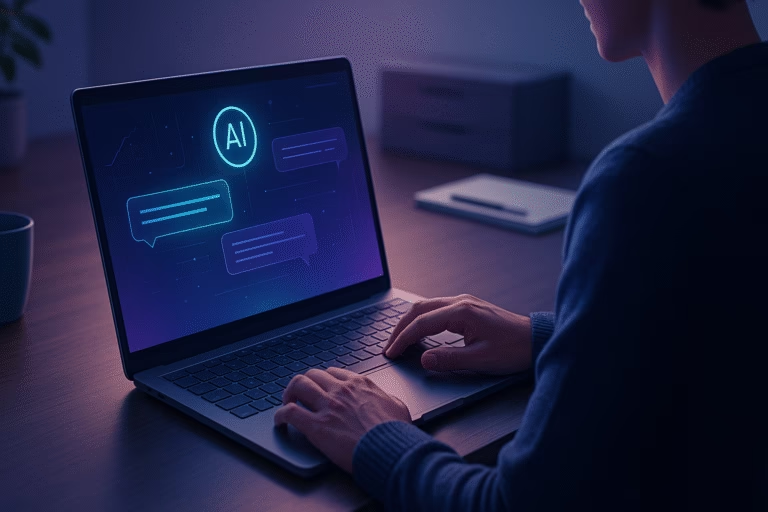ChatGPT Prompt Guide: Techniques, Plugins, and AI Tools You Need to Know

Artificial intelligence has quickly moved from novelty to necessity. In 2025, ChatGPT and other AI-powered assistants are being used for everything from writing blog posts to debugging code, creating marketing campaigns, and tutoring students. But while the technology is powerful, one challenge remains: getting the best results depends on how you prompt it.
That’s where this guide comes in. Based on the popular ChatGPT prompt guides circulating online, we’ve extracted the important bits and transformed the visuals into an educational blog version: complete with explanations, examples, and structured tables. Whether you’re an AI beginner or a seasoned pro, you’ll find practical ways to get more out of ChatGPT.
Learning How to Prompt
Before diving into advanced tricks, it’s crucial to understand the basic types of prompts. Think of these as the building blocks for how you communicate with ChatGPT. The clearer your input, the more useful your output will be.
Here’s a breakdown of common prompt types:
| Type | Description | Example Use Case |
|---|---|---|
| Open-Ended | Broad prompts that encourage detailed responses. | “Tell me about renewable energy trends in Europe.” |
| Multiple Choice | Give ChatGPT options to choose from. | “Which of these is heavier? A) 1kg of feathers B) 1kg of lead.” |
| Fill-in-the-Blank | Ask ChatGPT to complete a phrase or sentence. | “AI is transforming ___ industries.” |
| Binary | Yes/No style prompts for quick answers. | “Is the Earth flat?” |
| Orderly | Step-by-step instructions. | “List the 5 steps for writing a business plan.” |
| Prediction | Ask ChatGPT to forecast or anticipate outcomes. | “What skills will be most valuable in 2030?” |
| Explanation | Request a clear breakdown of a topic. | “Explain blockchain as if I’m new to finance.” |
| Opinion | Invite ChatGPT to share perspectives. | “What’s the best productivity method?” |
| Scenario | Create a hypothetical situation. | “Imagine you’re the CEO of a startup with no budget…” |
| Instruction | Direct and specific task commands. | “Write a press release for a mobile app launch.” |
| Feedback | Ask for reviews or critiques. | “Evaluate my LinkedIn summary and suggest improvements.” |
Aya’s pro tip Mix and match these prompt styles. For example, you can combine Instruction (“Write a blog post outline”) with Scenario (“as if you’re a travel blogger”) to get even sharper results.
Prompting Techniques That Work
Once you’ve mastered the basics of prompt types, the next step is learning how to shape and guide ChatGPT’s responses. These techniques can dramatically change the quality of the output you get.
Here’s a breakdown of the most effective prompting methods:
| Technique | How It Works | Example Prompt |
|---|---|---|
| Role Playing | Assign ChatGPT a specific role to influence tone and perspective. | “Act as a career counsellor and suggest job options for someone with design skills and analytical thinking.” |
| Add Examples | Provide sample answers so the model learns your preferred style. | “Here are 3 examples of catchy CTAs. Now create 5 more in the same style.” |
| Temperature | Adjusts creativity vs. accuracy. Lower = precise, higher = more creative. | “Summarise this research article” (temperature 0.2 = factual; 0.8 = more interpretive). |
| Style | Define the tone, format, or writing approach. | “Write this product description in a humorous tone.” |
| Chained Prompts | Break tasks into smaller steps and build on each. | “First, outline an essay on climate change. Then, expand section 1 into 3 paragraphs.” |
| Linked Prompts | Connect responses by reusing answers from earlier prompts. | “Use the marketing plan you just wrote and create a matching email campaign.” |
| Tree of Thought | Explore multiple reasoning branches instead of one answer. | “List 3 strategies for reducing food waste, then give pros and cons for each.” |
| Instructional | Give very clear and structured directions. | “Summarise this article in exactly 3 bullet points, each under 10 words.” |
Why These Techniques Matter
- Role playing helps ChatGPT adapt to your context. It’s like putting on the right “hat” before starting work.
- Examples give you consistency, especially for marketing copy or branding.
- Temperature is an underused control that can switch ChatGPT from “safe and factual” to “creative brainstorming mode.”
- Chained and linked prompts mimic how humans think: step by step, connecting ideas.
- Tree of Thought is perfect for decision-making and problem-solving.
- Instructional prompts eliminate vagueness and save time.
Aya’s pro tip Start with a general request, then refine using techniques. For instance:
- First ask for a blog outline (instructional).
- Then role play as a copywriter to polish headlines (role playing).
- Finally, adjust tone to match your brand voice (style).
Writing Styles with ChatGPT
One of ChatGPT’s strengths is its ability to shift writing style on demand. This makes it useful for marketing teams, teachers, bloggers, or anyone who needs different tones for different audiences.
Here are some of the most effective styles you can request:
| Style | When to Use It |
|---|---|
| Formal | Business reports, legal documents, academic writing |
| Informal | Casual blog posts, newsletters, social media |
| Persuasive | Marketing copy, sales emails, fundraising appeals |
| Descriptive | Storytelling, creative writing, product reviews |
| Humorous | Social content, light-hearted campaigns |
| Confrontational | Debates, opinion pieces, sparring arguments |
| Inspirational | Motivational speeches, coaching, personal branding |
Why This Matters
- Consistency: Brand voice matters. The wrong style can confuse your audience.
- Efficiency: Instead of rewriting drafts in your voice, just tell ChatGPT the style you want upfront.
- Experimentation: You can try new tones without committing. See how a formal report reads in a persuasive style, or test humor in a sales pitch.
Aya’s pro tip Combine style with role playing. For example:
“Act as a marketing manager and write a persuasive product pitch in a humorous tone.”
Acting as Roles
One of the most powerful ways to get better outputs from ChatGPT is to assign it a role. Instead of asking it a question in plain terms, you tell it who to be. For example: a teacher, a lawyer, a coach, or even a customer support agent. This small tweak makes a big difference in tone, structure, and usefulness.
Here are some common (and creative) roles you can try:
| Role | Example Prompt |
|---|---|
| Teacher | “Explain fractions as if I’m 10 years old.” |
| Career Counsellor | “Suggest career paths for someone who loves art but also enjoys working with numbers.” |
| Translator | “Translate this paragraph into Spanish, keeping a professional tone.” |
| Travel Guide | “Plan a 3-day trip to Tokyo on a budget of $500.” |
| Personal Trainer | “Create a weekly workout plan for a beginner with no equipment.” |
| Financial Assistant | “Help me create a monthly budget for $3,000 income and $1,800 expenses.” |
| Customer Service Agent | “Write a polite response to a customer complaining about late delivery.” |
| Interviewer | “Ask me 5 challenging interview questions for a marketing role.” |
| Lawyer | “Explain GDPR in plain English for a small business owner.” |
| Software Developer | “Debug this Python script and explain what was wrong.” |
| Creative Roleplay | “Pretend you’re a selfish AI bot whose only goal is world domination. How would you negotiate with humans?” (for fun, but useful to explore perspectives) |
Why Roles Are So Effective
- Context Framing: Giving ChatGPT a “job” helps it filter information and respond in the most relevant way.
- Tone Control: Roles naturally adjust formality, clarity, and voice.
- Exploration: You can explore multiple perspectives by switching roles useful in business planning, education, or brainstorming.
Aya’s pro tip Stack roles with styles and techniques. Example:
“Act as a lawyer. Write a persuasive (style) explanation of why my contract needs a non-compete clause, in bullet points (instructional).”
Extensions for ChatGPT
While ChatGPT is powerful on its own, its functionality can be extended with browser add-ons and third-party tools. These extensions add features like live web access, social media automation, and improved productivity.
Here are some of the most popular and useful extensions:
| Extension | What It Does |
|---|---|
| WebChatGPT | Gives ChatGPT access to real-time web search, so answers aren’t limited to its training data. |
| ChatGPT Writer | Generates complete emails or replies directly inside Gmail and other platforms. |
| TweetGPT | Helps you create tweets (serious or humorous) on demand. |
| Find Prompts | A community-driven library to discover and share new prompt ideas. |
| ChatGPT as Search | Lets you use ChatGPT as a search engine alternative. |
| ChatOnAI | Adds extra integrations and productivity features. |
| Prompthub | A collaborative platform for exploring, testing, and refining prompts. |
Why Use Extensions?
- Stay Current: ChatGPT’s base model may not always be up to date. Extensions like WebChatGPT fix this.
- Save Time: Tools like ChatGPT Writer automate repetitive email tasks.
- Boost Creativity: TweetGPT or Prompthub are great for brainstorming new content formats.
- Personalisation: Extensions make ChatGPT adapt better to your workflows, from research to social media.
Aya’s pro tip Don’t overload on extensions. Pick the 1–2 that truly fit your workflow and master them.
Plugins: The Best ChatGPT Plugins to Date
Unlike browser extensions, ChatGPT plugins are tools built directly into the ChatGPT environment. They allow the model to perform specialised tasks like shopping and price comparisons as well as creating charts or pulling files from your Google Drive.
Here’s a breakdown of the most useful plugins in 2025:
| Plugin | What It Does |
|---|---|
| Connect API Key | Lets you integrate external APIs, so ChatGPT can fetch data directly from other services. |
| Create Realistic Art | Generates AI-driven artwork and images within your chat workflow. |
| Shop & Compare Prices | Helps you browse, compare, and find deals across e-commerce platforms. |
| Create Excel Formulas | Instantly generates formulas for Excel or Google Sheets. |
| Generate Charts | Transforms data into clear visual charts and graphs. |
| Enter Google Drive | Connects to your Google Drive for file access and summarisation. |
| Spotify Plugin | Recommends playlists and music tailored to your mood or tasks. |
| Zapier Plugin | Automates tasks across 5,000+ apps (Slack, Gmail, Notion, etc.) directly from ChatGPT. |
| Other Integrations | From travel bookings to productivity apps, the plugin ecosystem continues to expand. |
Why Plugins Matter
- Direct Power-Up: Unlike copy-pasting between apps, plugins make ChatGPT a central hub for work.
- Productivity Boost: Automate repetitive tasks, generate data-driven visuals, or shop smarter.
- Future-Proofing: The plugin ecosystem is growing fast, making ChatGPT more like an operating system for AI.
Aya’s pro tip Start with 1–2 plugins that solve real problems in your workflow (e.g., Zapier for automation, Google Drive for document access) before experimenting with fun extras like Spotify.
Best Prompts for Marketing & Growth
Prompts aren’t just about asking questions, they’re about unlocking productivity and creativity. If you’re a marketer, entrepreneur, or content creator, these ready-to-use prompts can save hours of work and spark fresh ideas.
Here are some of the most popular (and effective) prompts from cheat sheets shared online, adapted into practical examples:
- Make ChatGPT write your code
→ “Write a Python script that scrapes the titles of the top 10 news articles from BBC.” - Correct grammar and spelling
→ “Proofread the following email for grammar, spelling, and clarity: [paste email].” - Draft tweets, LinkedIn posts, or captions
→ “Write 5 engaging LinkedIn post ideas about remote work trends.” - Generate YouTube video scripts
→ “Write a 5-minute YouTube script for a beginner’s guide to meditation.” - Create blog outlines
→ “Outline a 1,200-word blog post about sustainable fashion trends.” - Brainstorm startup ideas
→ “Suggest 10 startup ideas that use AI in the healthcare industry.” - Perfect product descriptions
→ “Write a persuasive product description for a wireless standing desk lamp, 150 words.” - Summarise long articles
→ “Summarise the following article in 5 bullet points under 15 words each: [paste article].” - Create captions with hashtags
→ “Write 3 Instagram captions for a coffee shop’s morning promotion, each with trending hashtags.” - Build quizzes and exam questions
→ “Generate 10 multiple-choice questions about European history with correct answers marked.” - Generate SEO-friendly blog ideas
→ “Give me 20 SEO-friendly blog post titles about digital marketing in 2025.”
Why These Prompts Work
- They save time by automating repetitive writing tasks.
- They help you scale creativity from blog posts to social media.
- They are versatile, easily adapted to different industries and needs.
Aya’s pro tip Always refine the output. Prompts give you a strong starting point, but the best results come from reviewing and personalising the content.
Vocabulary for Non-Tech People
If you’re new to AI, some of the jargon around ChatGPT and large language models (LLMs) can feel overwhelming. Here’s a simple glossary to keep things clear:
| Term | Meaning |
|---|---|
| Input | The text or instructions you type into ChatGPT. |
| Output | The response that ChatGPT generates based on your input. |
| Prompt | A specific instruction or question you give the model. |
| LLM (Large Language Model) | The type of AI behind ChatGPT trained on massive amounts of text to predict and generate words. |
| Generative AI | A category of AI that creates new content: text, images, music, or code. Rather than just analysing data. |
| OpenAI | The research company that developed ChatGPT. |
| Training | The process of feeding huge amounts of text into the model so it can learn patterns of language. |
| Prompt Engineering | The skill of crafting better inputs (prompts) to guide the AI towards useful, accurate, and creative outputs. |
Why This Matters
- Clarity builds confidence: You don’t need a computer science degree to use AI effectively.
- Demystifying AI terms makes the technology less intimidating and more practical for everyday business use.
- Better communication: Understanding the basics helps you ask smarter questions and collaborate with AI more effectively.
Aya’s pro tip Don’t get lost in jargon. If you understand “input” (what you ask) and “output” (what you get), you already have the foundation to use ChatGPT well.
Prompt Linking Techniques
ChatGPT really shines when you don’t treat prompts as one-off questions, but instead link them together. By building step by step, you can turn a rough idea into a polished piece of content, a marketing strategy, or even a research report.
Here’s a simple workflow to follow:
- Start with an outline
→ “Create an outline for a 1,000-word blog post on the future of electric vehicles.” - Expand each section
→ “Expand section 1 into three detailed paragraphs, including examples.” - Add subheadings or bullet points
→ “Turn section 2 into 5 key bullet points, each under 12 words.” - Ask for refinements
→ “Rewrite section 3 in a more persuasive tone aimed at investors.” - Generate supporting material
→ “Based on the outline, suggest 10 SEO-friendly titles for this blog post.”
Why Prompt Linking Works
- Keeps ChatGPT focused: Breaking tasks into smaller steps reduces vague or generic answers.
- Boosts creativity: Each step builds on the last, giving you layered insights.
- Saves editing time: Instead of reworking a long messy answer, you refine piece by piece.
Aya’s pro tip Treat ChatGPT like a collaborator. You wouldn’t expect a colleague to draft a perfect 1,500-word report in one go. You’d likely build it together. Do the same with prompts.
MidJourney Prompts
While ChatGPT specialises in text, many users also experiment with AI image generation through tools like MidJourney. Just like ChatGPT, the quality of your results depends heavily on the prompt you use.
Here are some core prompt tips for MidJourney:
| Prompt Element | What It Does | Example |
|---|---|---|
| Formatting | Define structure and ratios for the image. | --ar 16:9 → creates a widescreen aspect ratio. |
| Keywords | The descriptive words that shape your image. | “Cyberpunk city at night, neon lights, futuristic cars.” |
| Style Modifiers | Influence artistic direction. | “Oil painting, surrealist style, hyper-detailed.” |
| Lighting Effects | Add mood and depth. | “Golden hour lighting, cinematic shadows.” |
| Copy to Discord | MidJourney runs in Discord: once you craft your prompt, paste it there to generate images. | Type directly into MidJourney’s Discord bot. |
Why This Matters
- Precision: Adding details like lighting, style, or aspect ratio transforms results from generic to professional.
- Consistency: Save and reuse prompt templates for a consistent look across projects.
- Cross-Tool Creativity: Combine ChatGPT + MidJourney. Example: ask ChatGPT to generate 10 creative art prompts, then feed them into MidJourney.
Aya’s pro tip Always experiment. Change just one word (e.g., “realistic” → “fantasy”) and see how dramatically the image shifts.
Tips to Remember
Mastering ChatGPT doesn’t mean memorising hundreds of tricks, it’s about using a few core habits consistently. Here are some quick reminders to keep in mind every time you open a new chat:
- Categorise your prompts: Be clear whether you’re asking for an outline, a summary, or creative brainstorming.
- Be specific: The more detail you give, the sharper the answer.
- Ask for formats: Use instructions like “Write in a table” or “Summarise in bullet points.”
- Experiment with temperature: Lower values for accuracy, higher for creativity.
- Roleplay when needed: Assign ChatGPT a role (teacher, lawyer, marketer) to guide tone and perspective.
- Iterate, don’t expect perfection: Treat ChatGPT like a collaborator, not a one-shot oracle.
- Fact-check outputs: Especially for data, stats, or niche knowledge always verify before using.
- Save good prompts: Build your own mini “prompt library” for recurring tasks.
Aya’s pro tip Consistency beats complexity. A handful of reliable prompting habits will take you further than chasing every “hack” online.
Conclusion
ChatGPT has become one of the most versatile tools in the digital world, but like any tool, it’s only as good as the way you use it. Mastering prompts, exploring roles, leveraging plugins, and understanding the basics of how it works can transform your results from average to outstanding.
The good news? You don’t need to be a tech expert to get there. With the techniques and examples in this guide, you can approach ChatGPT with clarity and confidence; whether you’re writing, coding, brainstorming, or running a business.
AI isn’t just about speed. It’s about using the right strategies to get reliable, creative, and useful outputs. And as the ecosystem of extensions, plugins, and integrations continues to grow, the opportunities for professionals will only expand.
At AgentAya, we believe in cutting through the noise and making AI practical, accessible, and trustworthy. If you found this guide helpful, bookmark it, share it with a colleague, and start experimenting with these techniques today.
Because the future of AI isn’t just about technology, it’s about how you use it.




